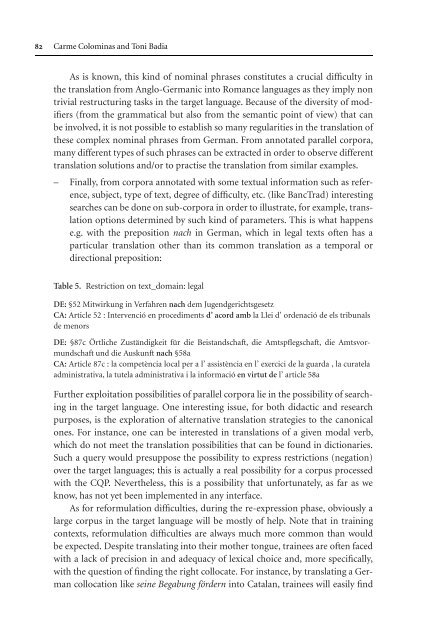Topics in Language Resources for Translation ... - ymerleksi - home
Topics in Language Resources for Translation ... - ymerleksi - home
Topics in Language Resources for Translation ... - ymerleksi - home
- No tags were found...
Create successful ePaper yourself
Turn your PDF publications into a flip-book with our unique Google optimized e-Paper software.
82 Carme Colom<strong>in</strong>as and Toni BadiaAs is known, this k<strong>in</strong>d of nom<strong>in</strong>al phrases constitutes a crucial difficulty <strong>in</strong>the translation from Anglo-Germanic <strong>in</strong>to Romance languages as they imply nontrivial restructur<strong>in</strong>g tasks <strong>in</strong> the target language. Because of the diversity of modifiers(from the grammatical but also from the semantic po<strong>in</strong>t of view) that canbe <strong>in</strong>volved, it is not possible to establish so many regularities <strong>in</strong> the translation ofthese complex nom<strong>in</strong>al phrases from German. From annotated parallel corpora,many different types of such phrases can be extracted <strong>in</strong> order to observe differenttranslation solutions and/or to practise the translation from similar examples.– F<strong>in</strong>ally, from corpora annotated with some textual <strong>in</strong><strong>for</strong>mation such as reference,subject, type of text, degree of difficulty, etc. (like BancTrad) <strong>in</strong>terest<strong>in</strong>gsearches can be done on sub-corpora <strong>in</strong> order to illustrate, <strong>for</strong> example, translationoptions determ<strong>in</strong>ed by such k<strong>in</strong>d of parameters. This is what happense.g. with the preposition nach <strong>in</strong> German, which <strong>in</strong> legal texts often has aparticular translation other than its common translation as a temporal ordirectional preposition:Table 5. Restriction on text_doma<strong>in</strong>: legalDE: §52 Mitwirkung <strong>in</strong> Verfahren nach dem JugendgerichtsgesetzCA: Article 52 : Intervenció en procediments d’ acord amb la Llei d’ ordenació de els tribunalsde menorsDE: §87c Örtliche Zuständigkeit für die Beistandschaft, die Amtspflegschaft, die Amtsvormundschaftund die Auskunft nach §58aCA: Article 87c : la competència local per a l’ assistència en l’ exercici de la guarda , la curatelaadm<strong>in</strong>istrativa, la tutela adm<strong>in</strong>istrativa i la <strong>in</strong><strong>for</strong>mació en virtut de l’ article 58aFurther exploitation possibilities of parallel corpora lie <strong>in</strong> the possibility of search<strong>in</strong>g<strong>in</strong> the target language. One <strong>in</strong>terest<strong>in</strong>g issue, <strong>for</strong> both didactic and researchpurposes, is the exploration of alternative translation strategies to the canonicalones. For <strong>in</strong>stance, one can be <strong>in</strong>terested <strong>in</strong> translations of a given modal verb,which do not meet the translation possibilities that can be found <strong>in</strong> dictionaries.Such a query would presuppose the possibility to express restrictions (negation)over the target languages; this is actually a real possibility <strong>for</strong> a corpus processedwith the CQP. Nevertheless, this is a possibility that un<strong>for</strong>tunately, as far as weknow, has not yet been implemented <strong>in</strong> any <strong>in</strong>terface.As <strong>for</strong> re<strong>for</strong>mulation difficulties, dur<strong>in</strong>g the re-expression phase, obviously alarge corpus <strong>in</strong> the target language will be mostly of help. Note that <strong>in</strong> tra<strong>in</strong><strong>in</strong>gcontexts, re<strong>for</strong>mulation difficulties are always much more common than wouldbe expected. Despite translat<strong>in</strong>g <strong>in</strong>to their mother tongue, tra<strong>in</strong>ees are often facedwith a lack of precision <strong>in</strong> and adequacy of lexical choice and, more specifically,with the question of f<strong>in</strong>d<strong>in</strong>g the right collocate. For <strong>in</strong>stance, by translat<strong>in</strong>g a Germancollocation like se<strong>in</strong>e Begabung fördern <strong>in</strong>to Catalan, tra<strong>in</strong>ees will easily f<strong>in</strong>d
















